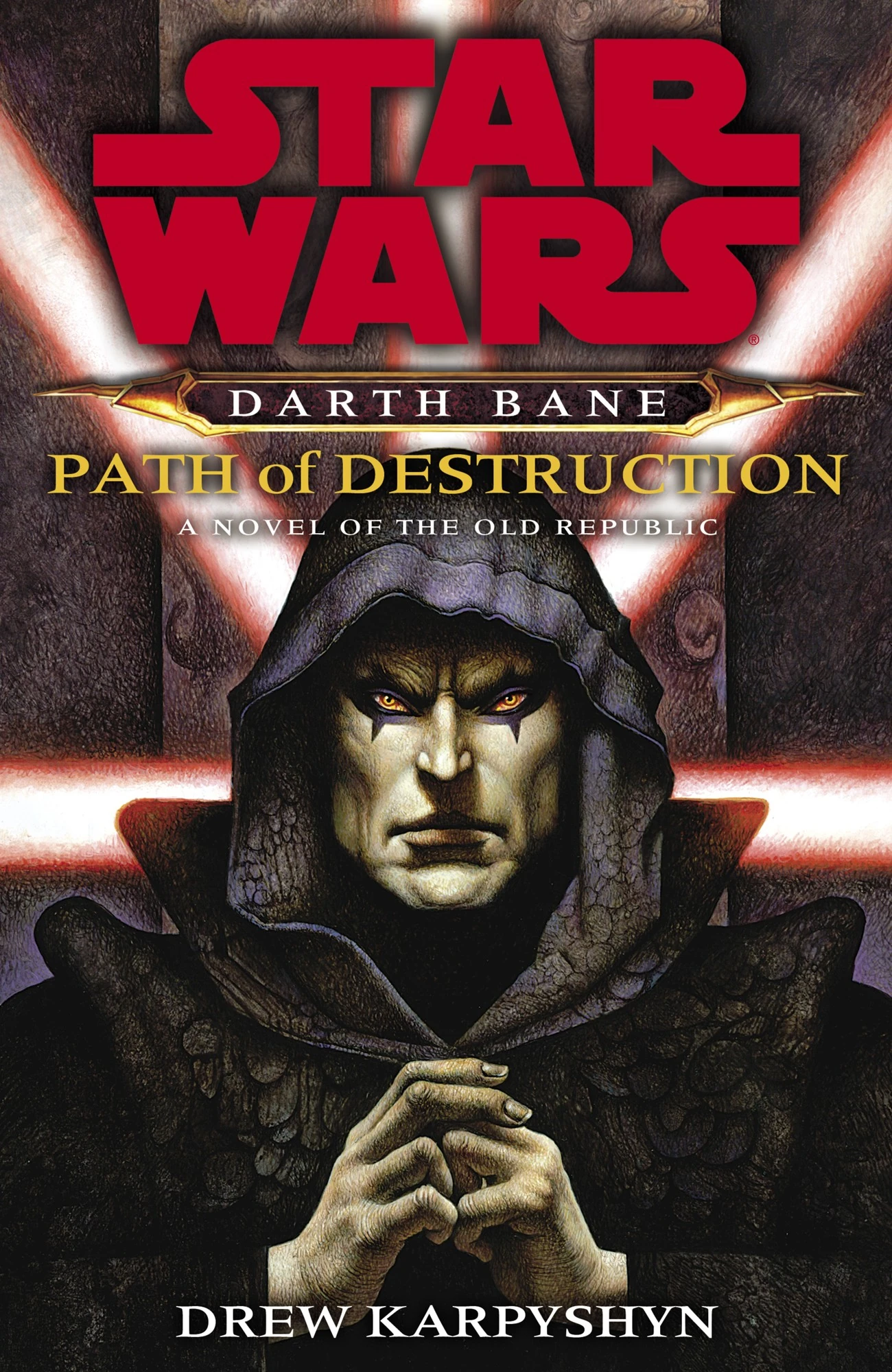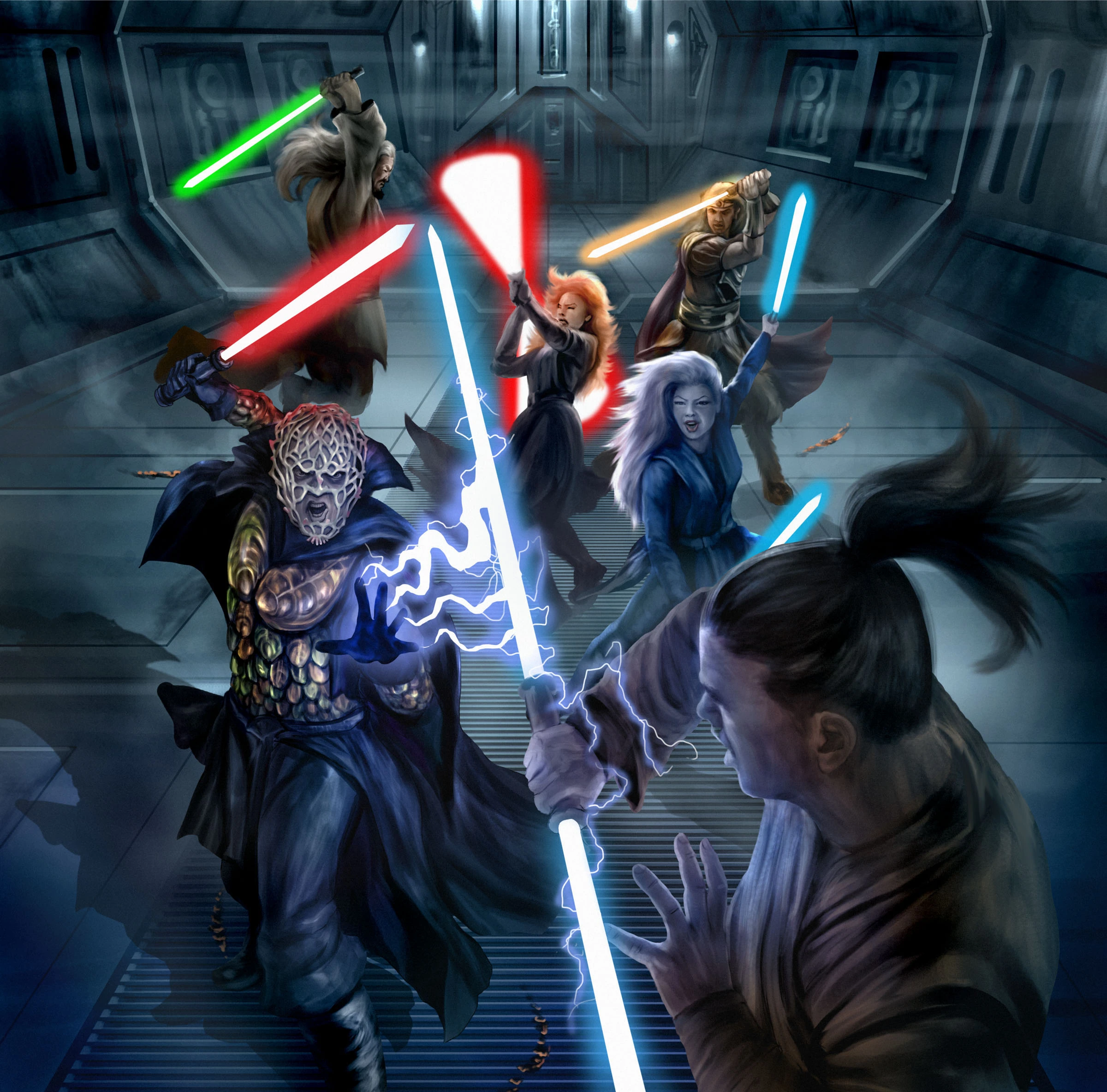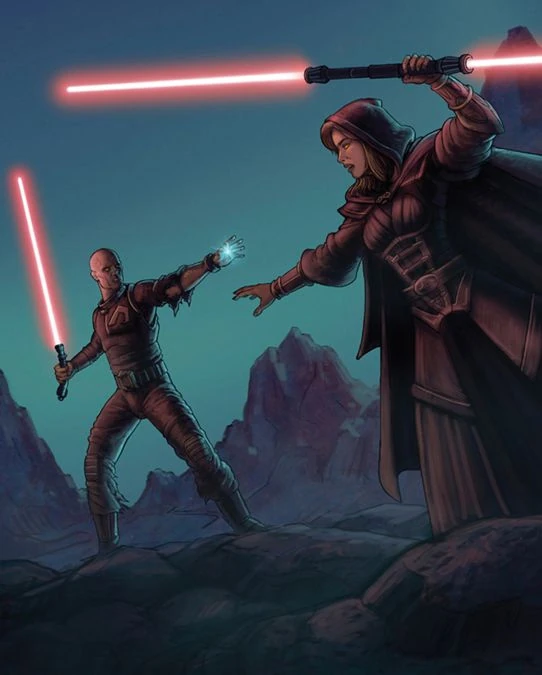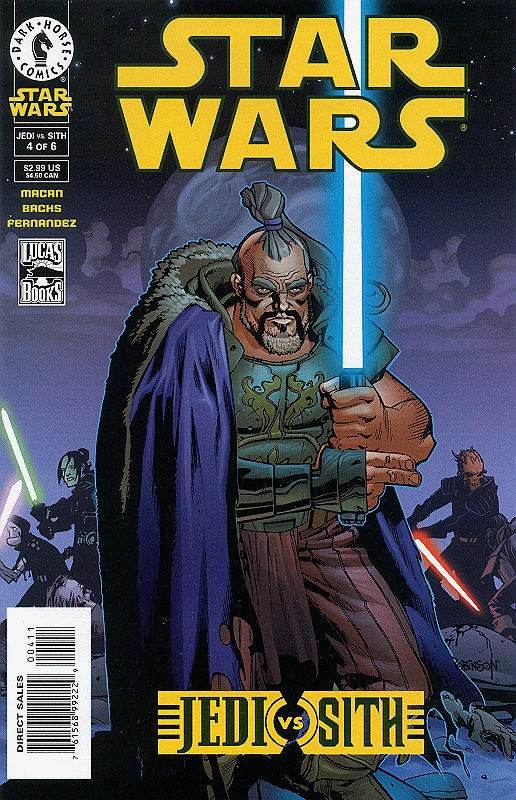In the final moments of Episode I: The Phantom Menace, Yoda and Mace Windu discuss the fact that the enemy recently defeated by Obi-Wan Kenobi was a Sith, but that "Always two there are, no more, no less. A master and an apprentice." But the Sith we had seen in stories set earlier (written both before and after) featured entire empires of Sith. At some point, the Sith way changed from being empires of many down to only two individuals. The stories I read for this post (below) chronicle that transition and the Sith Lords that brought it about.
Follow @C_Andrew_H
- Darth Bane: Path of Destruction (novel by Drew Karpyshyn, 2006)
- Jedi vs. Sith 1-6 (comic by Darko Macan, 2001)
- Darth Bane: Rule of Two (novel by Drew Karpyshyn, 2007)
- Darth Bane: Dynasty of Evil (novel by Drew Karpyshyn, 2009)
I read Jedi vs. Sith in the Trade Paperback format. Path of Destruction and Rule of Two I read as paperback novels, while Dynasty of Evil was read as a hardcover novel. There is a short story, Bane of the Sith (Kevin J. Anderson, 2001) that was set around this time, but is unavailable and was largely contradictory to other sources (key elements of it were factored into Rule of Two).
 |
| Cover of Darth Bane: Path of Destruction. Image from Wookieepedia. |
Story:
These books tell the story of Darth Bane, the Sith Lord who rejected the current ways of the Sith to forge a new path to the future.
At the time of Path of Destruction, the Republic had begun to gain ground against the various Sith Lords that had taken over the Galaxy, their constant in-fighting (as seen in Knight Errant) weakening them considerably. The Sith Lord Kaan founded the Brotherhood of Darkness, a new Sith Empire that put all Sith Lords as equals under it (thus reducing the likelihood of in-fighting for dominance). The Sith of the Galaxy unite under the Brotherhood and make gains against the Republic, until the Jedi pool their entire order into a single Army of Light to confront them at the planet Ruusan.
Meanwhile, Bane (previously a miner named Dessel) is discovered by the Sith and trains in their academy on Korriban. He becomes an immensely powerful Sith Lord, but becomes disillusioned with the Brotherhood of Darkness. He studies the ancient texts and learns of the philosophy first conceived by Darth Revan (from Knights of the Old Republic), that there should only ever be two Dark Lords of the Sith: a master and an apprentice. He strongly favours this approach, and at the Seventh Battle of Ruusan tricks the Brotherhood of Darkness into wiping itself out, leaving only him and a young girl he takes as his apprentice, Darth Zannah, to plot revenge against the Jedi. Jedi vs. Sith depicts this same battle in a visual format, focussing more on Zannah and her cousins Bug and Tomcat.
Rule of Two began in the immediate aftermath of the battle, showing the first lessons Bane teaches Zannah in their escape from Ruusan, while certain obsessed Jedi hunt for Sith survivors. At the tomb of the Dark Lord Freedon Nadd (featured in Tales of the Jedi), Bane is set upon by parasites called Orbalisks, which grow on him and form a kind of lightsaber-resistant armor. The book jumps ten years in the future. Frustrated with failing to build a holocron (a repository of knowledge), Bane tracks down the fortress of former Sith Belia Darzu, whose holocron shows him what he was missing. Jedi, guided by Zannah's cousin (who, as a child, survived an encounter with Bane and Zannah) follow the Sith to Darzu's homeworld, and in a final showdown, the Jedi kill an enraged Tomcat, thinking he was the last Sith.
 |
| Bane and Zannah defending against Jedi. Image from Wookieepedia. |
An additional decade later, in Dynasty of Evil, Bane grows frustrated that Zannah had not yet challenged him. He learns of another ancient Sith, Darth Andeddu, who allegedly became immortal. He learns how to transfer his essence to others, but after a final confrontation fails to take over Zannah. She defeats him, and takes a former assassin, renamed Darth Cognus, as her apprentice.
Thoughts:
This is my last opportunity to enjoy stories set in ancient times, where empires of Sith fought thousands of Jedi in epic battles. I can only hope that the ancient era before the prequels becomes better explored in New Canon comics, books, or even movies in the coming years.
The Rule of Two is an interesting approach for the Sith. The idea that there can only be one master eliminates the in-fighting between Sith Lords, which results in the deaths of as many Sith as Jedi. The idea that the master should only have one apprentice eliminates the risk that multiple weaker apprentices will overthrow their master. A master will stay alive and teach their apprentice everything they know until the apprentice is strong enough to kill their master. If the apprentice is strong enough, he/she becomes the new master and is the stronger Sith, able to perpetuate their ways. If not, the apprentice has proven him/herself not ready and must either continue training or be replaced.
The problem is that, by the end of the story, there is no reason the Jedi should have known about the Rule of Two. They are unaware Bane survived, and believe they killed the only remaining Sith ten years after they wiped out the Brotherhood of Darkness. Bane ensures the Sith survive in hiding for close to a millennium, until the years before the Clone Wars, when Darth Maul and Count Dooku reveal themselves as Sith.
Darth Bane is in the New Canon, appearing in the final episode of The Clone Wars. All we know of him is that the Sith killed themselves and he reorganized them with the Rule of Two. Yoda knew who he was, so presumably he created the Rule of Two and then continued waging war against the Jedi and the Republic for a long time until they went into hiding. This is a good explanation as to why the Jedi are aware of the Rule of Two at the time of The Phantom Menace.
I found the Jedi vs. Sith comics to be really interesting. Written five years before Path of Destruction, it lacks so much of context that novel brings in. Path of Destruction adapted many scenes directly from the comic, and it was strange reading it in reverse publication order. I imagine new readers in 2001 would have been very confused, but having read about Kaan's Brotherhood of Darkness, Hoth's Army of Light, Darth Bane, and the other characters in the novel, it was very clear to me what was going on. Jedi vs. Sith also provided additional context to what brought Zannah and her two cousins to Ruusan and what pushed Zannah to the dark side. Zannah's cousin Darovit showed up in Rule of Two, and his story lined up with the comic. Many physical descriptions of characters and ships in Path of Destruction and Rule of Two lined up with their Jedi vs. Sith appearances as well. Overall, the comic was a fun addition to the saga; it need not be read to enjoy the Darth Bane series, but it does enhance the experience.
 |
| Final confrontation between Bane and Zannah. Image from Wookieepedia. |
The problem is that, by the end of the story, there is no reason the Jedi should have known about the Rule of Two. They are unaware Bane survived, and believe they killed the only remaining Sith ten years after they wiped out the Brotherhood of Darkness. Bane ensures the Sith survive in hiding for close to a millennium, until the years before the Clone Wars, when Darth Maul and Count Dooku reveal themselves as Sith.
Darth Bane is in the New Canon, appearing in the final episode of The Clone Wars. All we know of him is that the Sith killed themselves and he reorganized them with the Rule of Two. Yoda knew who he was, so presumably he created the Rule of Two and then continued waging war against the Jedi and the Republic for a long time until they went into hiding. This is a good explanation as to why the Jedi are aware of the Rule of Two at the time of The Phantom Menace.
 |
| Darth Bane in Legends (left) and New Canon (right). While they both created the Rule of Two, their stories must be quite different. Both images from Wookieepedia. |
I found the Jedi vs. Sith comics to be really interesting. Written five years before Path of Destruction, it lacks so much of context that novel brings in. Path of Destruction adapted many scenes directly from the comic, and it was strange reading it in reverse publication order. I imagine new readers in 2001 would have been very confused, but having read about Kaan's Brotherhood of Darkness, Hoth's Army of Light, Darth Bane, and the other characters in the novel, it was very clear to me what was going on. Jedi vs. Sith also provided additional context to what brought Zannah and her two cousins to Ruusan and what pushed Zannah to the dark side. Zannah's cousin Darovit showed up in Rule of Two, and his story lined up with the comic. Many physical descriptions of characters and ships in Path of Destruction and Rule of Two lined up with their Jedi vs. Sith appearances as well. Overall, the comic was a fun addition to the saga; it need not be read to enjoy the Darth Bane series, but it does enhance the experience.
 |
| Lord Hoth and various Jedi and Sith on cover of Jedi vs. Sith #4. Image from Wookieepedia. |
One thing that annoyed me (which is unavoidable) is that these books do not take into account stories that took place earlier but were written later. This is, of course, impossible to correct for. Darth Bane knew nothing of the Sith Empire that ruled in the time of The Old Republic, but in the real world no author had yet conceived of that story. It can be argued, of course, that millennia had passed and much knowledge had been lost, or simply not been taught to him. Another solution is that I could have read in release order, but that seemed less fun.
Next:
I'm about to finish re-watching Star Wars: The Clone Wars, and so my next post will be about that TV show and related New Canon material. When we next revisit Legends, we begin a three-part prelude to The Phantom Menace, beginning with all stories featuring Qui-Gon Jinn and Obi-Wan Kenobi.
Follow @C_Andrew_H
Comments
Post a Comment